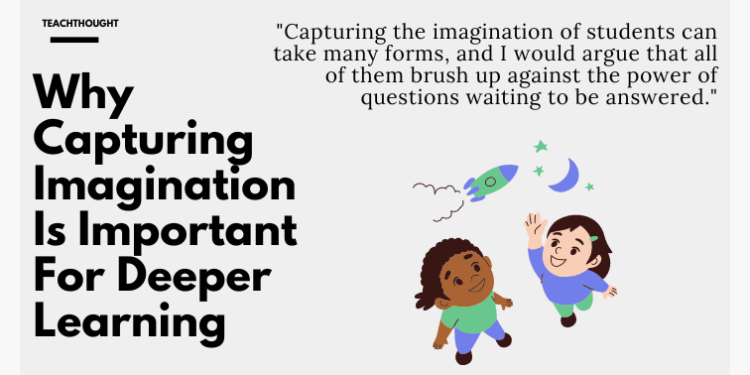by Drew Perkins, Director of TeachThought PD
I miss teaching.
Not so much the rigors of bells, short breaks, endless supervision duty, multiple preps, rushed lunches, and the paperwork. But I miss the actual moments in my classes where I captured the imagination of students. I still get that privilege when I facilitate our professional development, but there’s something different about hooking a student into a moment of profound thinking. Not only because it is a moment of enlightenment but also because it is a gateway to deeper learning.
Much has been made of the importance of effective instruction, including in my recent piece, 3 Questions To Help Make ‘Deeper Learning’ Work, and I do think it is essential and sometimes overlooked in pursuit of student engagement. But in most of my conversations with or readings from the ‘science of learning’ advocates, I’m generally left feeling like they’re leaving out something significant.
While I certainly think long term memory is important, as is direct instruction, I’m almost always left wanting by these kinds of writings that seem to end at knowledge and leave out understanding and deeper abstract conceptual learning.
— Drew Perkins (@dperkinsed) January 6, 2023
Getting students to learn more deeply requires their cognitive engagement, and that rarely comes without them being interested. Yes, it is true that learning often leads to motivation, as students feel a sense of success and efficacy. Certainly, the opposite is intuitively true; when a student is struggling and left feeling defeated, their motivation will be halted. While knowledge is necessary for deeper learning, it is not sufficient.
Capturing the imagination of students can take many forms, and I would argue that all of them brush up against the power of questions waiting to be answered. Sometimes they are ‘in the moment’ kinds of phenomenon, planned by the teacher to inspire awe, create cognitive dissonance, or allow students to experience something new.
Other times they are more macro. Perhaps a teacher who, over the course of a semester, models thinking in a way that pushes and inspires student thinking. Or a Project-Based Learning experience, like our Straw Project Exemplar, that is meant to surface those ‘a-ha’ moments. Or perhaps an engagement with content and knowledge in ways that connect to the ideas, thoughts, and questions of others like Socratic Seminar, World Cafe Conversations, or a structured protocol like the ones developed by one of our partners, the NSRF.
In my high school psychology classroom, I used all kinds of things to lead student thinking and capture their curiosity. When teaching about sensation and perception, I brought in a magician to perform for them. For our unit on consciousness, I led them through a brief meditation exercise. When we studied disorders, we took a field trip to a local psychiatric hospital.
In my government classroom, I had our local Kentucky State Representative ask them to propose budget policy recommendations that fit the needs of his constituents. In my economics classroom, I brought in an official from the Federal Reserve System and another time, as part of a Project-Based Learning experience, asked students to pitch an entrepreneurial idea for a new sneaker. In my middle school history class we placed a live call into C-SPAN and were featured on a national news program when we visited a local veterans home.
None of those kinds of things necessarily lead to deeper learning, and we have to be mindful that exciting moments with our classes and students aren’t sufficient either. But paired with dynamic inquiry and effective instruction, they all have the potential to move students from a mindset of compliance by generating interest and spurring beautiful questions.
In fact, it isn’t always necessary to plan things of this scale. It is quite possible to capture student imagination and curiosity with simple exercises like the Question Formulation Technique.
Imagine the wondering questions that might emanate from elementary science students when asked to generate questions from this QFT Question Focus:
The amount of water on the earth now is the same as when dinosaurs existed.
Or what if we asked students studying civil rights to engage in a Visible Thinking Making Meaning Routine to define racism after watching Carlos Hoyt’s TEDx Talk demonstration with sugar and salt?
To achieve deeper learning, we can’t forget the principles of effective instruction to help students learn important knowledge. But cognitive engagement should not be limited to knowledge acquisition and changes in long-term memory. In fact, as Zach Groshell and I discussed in this recent podcast chat, there is considerable overlap between the ‘science of learning’ and ‘deeper learning’. Considering how to hook and hold student curiosity and use it to leverage them into critical thinking is key.
It isn’t good enough to loiter in the Remember and Understand levels of Bloom’s taxonomy. It is when students engage through processes like analysis, evaluation, synthesis, and creating that learners create deeper learning connections that transfer and endure for years to come.



















